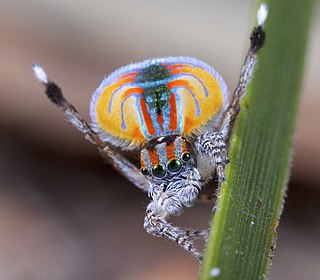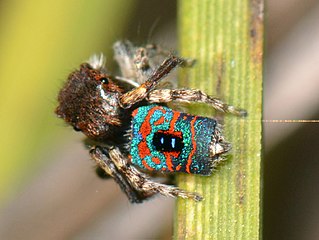
Maratus is a spider genus of the family Salticidae. These spiders are commonly referred to as peacock spiders due to the males' colorful and usually iridescent patterns on the upper surface of the abdomen often enhanced with lateral flaps or bristles, which they display during courtship. Females lack these bright colors, being cryptic in appearance. In at least one species, Maratus vespertilio, the expansion of the flaps also occurs during ritualised contests between males. The male display and courtship dance are complex, involving visual and vibratory signals.

Maratus volans is a species in the jumping spider family (Salticidae), belonging to the genus Maratus. These spiders are native to certain areas in Australia and occupy a wide distribution of habitats. They have a specialized visual system that allows them to see the full visible spectrum as well as in the UV-range; this helps them detect and pursue prey. Males of this species are characterized by their colorful abdomen flaps that are used to attract females during courtship.

Australia has a number of highly venomous spiders, including the Sydney Funnel-web, its relatives in the family Hexathelidae, and the Redback Spider, whose bites can be extremely painful and have historically been linked with deaths in medical records. Most Australian spiders do not have venom that is considered to be dangerously toxic. No deaths caused by spider bites in Australia have been substantiated by a coronial inquest since 1979. There are sensationalised news reports regarding Australian spiders that fail to cite evidence. A Field Guide to Spiders of Australia published by CSIRO Publishing in 2017 featuring around 836 species illustrated with photographs of live animals, around 381 genera and 78 families, introduced significant updates to taxonomy from Ramirez, Wheeler and Dmitrov

Maratus speciosus, sometimes called the coastal peacock spider, is an Australian species of jumping spider. They are only known to inhabit the vegetation of the coastal sand dunes of southwestern Western Australia. Like other Maratus spiders, the males of the species engage in a courtship display during which they raise their third pair of legs and their abdomen, presenting their colorful opisthosomal plate to potential female partners. Unlike other Maratus, however, the males of this species have a set of bright orange hairs (setae) along both edges of the opisthosoma which only become visible during this display.
Maratus jactatus is a species of the genus Maratus, an Australian member of the jumping spider family. Maratus Jactatus have the ability to jump lengths up to 50 times their size of about 10mm. The female has a cryptically colored back, whereas the male has the colorful back. They have been collected only in Wondul Range National Park in southern Queensland. Like other Maratus spiders, the males of the species engage in a courtship display, during which they extend their median and posterior fringed spinnerets. They also spread the flaps from over their inflated opisthomal plate, revealing unique iridescent blue scales "interrupted by three bold transverse bands of red-orange to orange pigmented scales." A male presents both the extended spinnets and his expanded and inflated opisthoma as he faces the female that he courts. However, depending on the colors of the male, the female may be more likely to go to another male or not be attracted to certain males.
Maratus sceletus is a species of the genus Maratus, an Australian member of the jumping spider family. Described in 2015, they have been collected only in Wondul Range National Park in southern Queensland. The species name is derived from the Latin sceletus "skeleton", from its distinctive body pattern. Maratus sceletus is a small species, from 3.7 to 4.7 mm long. The male is black with prominent white stripes and markings across its carapace and legs.

Maratus nigromaculatus is a species of the genus Maratus, an Australian member of the jumping spider family. Described in 1883 by Keyserling as Ergane nigromaculata from a specimen from Rockhampton, they are found in Queensland. The species name is derived from the Latin words niger "black" and maculatus "spotted".

Maratus spicatus is a species of the genus Maratus, an Australian member of the jumping spider family. It was described in 2012 and is native to Western Australia.
Maratus albus is a species of the peacock spider genus, characterised by its distinctive courtship display.
Maratus australis is a species of the peacock spider genus, characterised by its distinctive courtship display.
Maratus vespa is a species of the peacock spider genus, Maratus, characterised by its distinctive courtship display. The male spiders are characterized by a bright abdomen, lateral flaps, and an elongated third pair of legs. When attempting to attract a mate, the male spider will raise its colorful abdomen and elongated third pair of legs and wave them, along with extending its lateral flaps. This complex display of courtship is analogous of that of a peacock, hence the common name of this spider species.
Maratus vultus is a species of the peacock spider genus, characterised by its distinctive courtship display.
Maratus proszynskii is a species of the genus Maratus, first found in Tasmania.
Maratus unicup is a species of jumping spider of the genus Maratus.
Maratus felinus is a species of peacock spider native to Australia. It was discovered at Lake Jasper and Mount Romance along with two other species, Maratus aquilus and Maratus combustus.
Maratus combustus is a species of peacock spider native to Australia. The species was discovered together with Maratus felinus and Maratus aquilus by a research group from Monash University, near Lake Jasper in the South West region of Western Australia. However, the ranges of each species do not overlap.

Maratus pavonis is a species of jumping spider (Salticidae), endemic to Australia, where it is found in Western Australia, New South Wales, Victoria and Tasmania. The species epithet, pavonis, derives from the Latin, pavo, pavonis, meaning "peacock".

Maratus mungaich, the banksia peacock spider, is a species of jumping spider in the family Salticidae. It is endemic to Western Australia.

Saitis mutans is a species of spider in the genus Saitis. It is endemic to Australia.

Maratus scutulatus is a species of Australian spider in the family Salticidae.









